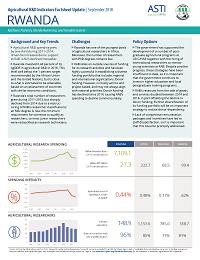Authors:
Kathleen Flaherty, Nienke Beintema, and Aimable Gatete
Year:
2018
Publisher
International Food Policy Research Institute and The Rwanda Agriculture and Animal Resources Development Board
Back to:
BACKGROUND AND KEY TRENDS
- Agricultural R&D spending grew by one-third during 2011–2014, driven be increased donor support to RAB, which declined thereafter.
- Rwanda invested 0.44 percent of its AgGDP in agricultural R&D in 2016. This level well below the 1 percent target recommended by the African Union and the United Nations but is close to what is estimated to be attainable (0.49 percent) based on an assessment of countries with similar economic conditions.
- Rwanda’s total number of researchers grew during 2011–2013, but sharply declined from 2014 due to a restructuring of RAB’s researcher classifications: an MSc degree is now the minimum requirement for scientists to qualify as researchers, so most junior researchers were reclassified as research technicians.
CURRENT CHALLENGES
- Rwanda has one of the youngest pools of agricultural researchers in Africa. Moreover, the number of researchers with PhD degrees remains low.
- RAB relies on outside sources of funding for its research activities and has been highly successful in establishing a diverse funding portfolio that includes regional and international organizations. Donor funding, however, is mostly ad hoc and project-based, and may not always align with national priorities. Donor funding has declined since 2014, causing RAB’s spending to decline commensurately.
POLICY OPTIONS
- The government has supported the development of a number of postgraduate agricultural programs at UR-CAVM, together with the hiring of international researchers to mentor young scientists at RAB. Despite positive progress, these strategies have been insufficient to date, so it is important that the government continues to invest in higher education and local postgraduate training programs.
- RAB’s revenues from the sale of goods and services doubled between 2014 and 2016, in part offsetting the decline in donor funding. Further diversification of its funding portfolio will be an important strategy to reduce donor dependency.
- Lack of competitive remuneration packages and incentives have led to staff dissatisfaction, so it is important that this issue be promptly addressed.

